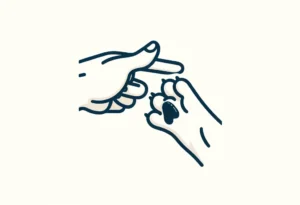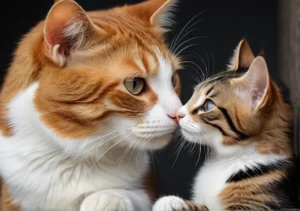Have you ever wondered why your cat squirms when you pet her? It can be frustrating when you’re trying to show your furry friend some love, only for her to wriggle away. But don’t worry, there are reasons behind this behavior that we are going to explore in this blog post.
When you pet your cat, she may squirm for a variety of reasons. It could be due to overstimulation, discomfort, or simply a preference for a different type of touch. Understanding why your cat squirms can help improve your bond and make petting sessions more enjoyable for both of you.
Sensory Overload: Why Does It Happen?
Have you ever noticed your cat squirming or trying to get away when you’re petting her? Well, one possible reason for this behavior is sensory overload. Just like humans, cats have a certain threshold for stimulation, and when that threshold is exceeded, they may feel overwhelmed and uncomfortable.
Cats have highly sensitive nerve endings in their skin, which is why they can be so particular about how and where they like to be petted. Too much petting in one area, especially in areas where they are not as fond of being touched, can lead to sensory overload. This can make your cat squirm or try to escape from the petting session.
To avoid triggering sensory overload in your cat, pay attention to her body language. Watch for signs like twitching skin, flattened ears, or a flicking tail, which could indicate that she’s becoming overstimulated. If you notice these cues, it’s best to give your cat a break from petting to allow her to calm down.
For more information on understanding your cat’s body language and how to avoid sensory overload during petting sessions, check out this helpful resource on feline behavior: Understanding Cat Body Language
Remember, sensitivity to your cat’s cues and respecting her boundaries during petting sessions can help ensure a more enjoyable and stress-free experience for both you and your feline friend.
Preferences and Boundaries: Respect Your Cat’s Wishes
Hey there! So, if your furry friend starts squirming when you pet her, it might be a sign that she’s not really feeling it. Cats, just like us, have their preferences and boundaries when it comes to affection. If your cat squirms, it’s essential to respect her wishes. Pay attention to her body language – if she starts tensing up or twitching her tail, she might be getting overstimulated. When you notice these signs, it’s best to give her some space and let her come to you when she’s ready for more love and attention. Remember, a happy cat means a happy pet parent!
Relaxation Techniques: Helping Your Cat Feel More Comfortable
Hey friend! When your cat squirms during petting, it could be a sign that she’s feeling a bit anxious or uncomfortable. To help your feline friend relax and enjoy the petting session, try incorporating some relaxation techniques. Start by petting her in her favorite spots, like behind the ears or under the chin. Gentle, slow strokes can help soothe her nerves and make her feel more at ease. You can also try incorporating some interactive playtime before petting to help her release any pent-up energy. Creating a calm and positive environment can go a long way in making your cat feel more comfortable and loved.
Additional Unique Insight: A helpful technique to promote relaxation in cats during petting is to try incorporating some calming scents, such as lavender or chamomile, into the environment. These soothing aromas can help create a serene atmosphere that encourages relaxation and peace for your furry companion.
Trust Building: Strengthening Your Bond with Your Cat
When petting your cat, focus on creating a calm and relaxing environment. Cats often squirm when they feel anxious or uncomfortable. By petting them gently and in a soothing manner, you can help them feel more at ease. Additionally, pay attention to your cat’s body language. If they start to squirm or show signs of distress, it may be a sign that they’ve had enough petting for the moment.
To build trust with your cat, spend quality time with them every day. This can include playing together, grooming them, or simply sitting quietly in their presence. By consistently showing your cat love and attention, you can strengthen your bond and reduce their tendency to squirm when you pet them.
Tips for Building Trust:
- Use slow, gentle movements when petting your cat.
- Offer treats or rewards during and after petting sessions.
- Create a safe and comfortable environment for your cat to relax in.
- Respect your cat’s boundaries and allow them to initiate physical contact.
Remember, building trust takes time and patience. Be consistent in your interactions with your cat, and soon you’ll notice them squirming less and enjoying your pets more.
Unique Personalities: Every Cat is Different
Just like people, cats have their own unique personalities and preferences. What works for one cat may not work for another when it comes to petting. Some cats may enjoy being petted for long periods, while others may only prefer brief interactions. Understanding your cat’s individual likes and dislikes is key to minimizing squirming during petting sessions.
Take the time to observe your cat’s behavior and body language. This can give you valuable insights into what they enjoy and what makes them uncomfortable. By tailoring your petting techniques to suit your cat’s preferences, you can create a more positive and enjoyable experience for both of you.
Remember, patience and understanding are essential when it comes to building a strong relationship with your cat. By respecting their unique personality and needs, you can foster a deeper bond and reduce their squirming behavior.
Key Points to Remember:
- Observe your cat’s body language and reactions during petting.
- Respect your cat’s individual preferences for physical contact.
- Be patient and understanding as you work to build trust with your cat.
- Tailor your interactions to suit your cat’s unique personality.
By embracing the individuality of your feline friend and adjusting your approach accordingly, you can create a harmonious relationship built on mutual trust and respect.
Professional Insights: What Do Experts Say?
When it comes to why your cat squirms when you pet her, feline behavior experts suggest that it may be due to overstimulation. Cats have different thresholds for physical contact, and some may become uncomfortable or agitated if they are petted for too long or in certain areas. It’s essential to pay attention to your cat’s body language – if she starts twitching her tail rapidly or swatting at your hand, it’s a clear sign that she’s had enough.
One expert insight to consider is that some cats have specific preferences when it comes to petting. While some may enjoy long strokes along their back, others may only like being petted for a short period or in specific spots. Understanding your cat’s individual likes and dislikes can help prevent her from squirming during petting sessions.
For more information on feline behavior and tips on how to keep your furry friend content, you can check out this resource on The American Society for the Prevention of Cruelty to Animals (ASPCA).
Fun Facts About Cat Behavior
Did you know that cats have a unique way of communicating through their body language? One fun fact about cat behavior is that they often squirm when being petted as a way of expressing discomfort or a desire for a change in physical contact. Just like humans, cats have their preferences and boundaries when it comes to touch.
Another interesting insight is that cats have sensitive areas on their bodies that they may not appreciate being touched. These include their bellies, tails, and feet. By respecting your cat’s boundaries and paying attention to her cues, you can create a more enjoyable experience for both of you during petting time.
Remember, every cat is different, so it’s essential to observe and understand your feline companion’s unique behavior and preferences to ensure a harmonious relationship. Happy petting!
Alex, a passionate animal lover, has experience in training and understanding animal behavior. As a proud pet parent to two dogs and three cats, he founded AnimalReport.net to share insights from animal experts and expand his knowledge of the animal kingdom.




